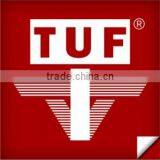vessel rudder system/ flap rudder/ marine rudder system
USD $1 - $1 /Set
Min.Order:1 Set
Quick Details View All >
Chongqing Perpetual Import And Export Co., Ltd.
Product Details
The marine rudder is a main part of the steering system for vessels. The whole rudder system includes rudder blade, rudder carrier, rudder pintle, rudder stock, etc. We can design different types of the rudders as the requirement of our clients.
The Flap Rudder is the ultimate rudder solution when it comes to ship manoeuvrability. With decades of research, development and practical experience behind it, this rudder is the most mature design of all flap rudders in the shipbuilding industry. Optimized profiles, rudder balance, deflection ratio between rudder blade and flap, hinge and link systems guarantee a reliable and efficient tool for your vessel.
The main structure of the flap rudder
Flap Rudder I Type
Rudder angles of +/-45 degrees and additional 45 degrees of the flap permit extreme manoeuvres and dynamic positioning operations. Each ship is different and for some rudder configurations rudder angles of 65°can be applied if a benefit for manoeuvring is expected. Also attractive is the improved course keeping performance and fuel saving obtained through smaller required rudder angles and smaller rudder area, compared to standard rudders.
The advantages of the flap rudders (I-type) are:
• Optimum balance and flap area
• Minimum steering gear size
• Highest insurance against flexural vibration
• High efficiency ratio design
• Highest safety against cyclic stresses
• Durable in heavy duty
• Easy maintenance of link and hinge system
Flap Rudder II Type
This type is an economical Rudder and especially suitable for the small and low speed vessels such as River boats, supply vessels, tug boats, fishing boats or research vessels can take advantage of this type of rudders for their special purposes.
The advantages of the Flap rudder (II-type) are:
• Better covering of propeller stream
• Reduction of the remaining forward thrust
• Easy installation
• Increase of side thrust
• Smaller rudder torque
• Smaller steering gear
• Less stresses of steering gear
Contact Supplier

You May Like

New Products
Popular Searches
Recommended Products
Find Similar Products By Category